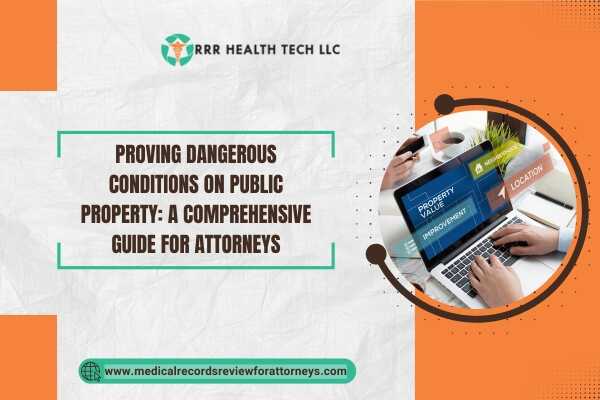
Introduction
Understanding how to prove a dangerous condition on public property coupled with a personal injury case can pose a challenge for many attorneys. In this article, we examine the statutory framework for liability and prevailing immunities, as well as detail more strategically how to win your case. Furthermore, we discuss how some medical record reviews may aid in supporting claims of dangerous conditions.
Understanding Dangerous Conditions on Public Property
Definition of a Dangerous Condition
• Legal Definition: A dangerous condition refers to a situation regarding a property that will foreseeably result in an injury if it is used with reasonable care.
• Examples: These include but are not limited to damages, destruction, and design imperfections that clear sight can reasonably predict will put users in danger.
Statutory Basis for Liability
• Government Code Section 835: A public entity is liable for injuring a person through a dangerous action if:
• The property was dangerous at the time of injury.
• The injury was directly linked to the condition considered dangerous.
• The public entity had actual or constructive notice of the condition.
Key Elements of Proving Liability
Establishing the Dangerous Condition
• Physical Evidence: Capturing photographs and having qualified specialists assess the property are useful in creating evidence of having purported the state of the property.
• Expert Testimony: Hiring professionals qualified to appraise the condition and assess its possible risks.
Proximate Cause
• Causation: Establishing a direct link between the injury sustained and the harmful condition.
• Foreseeability: The injury risk is predictable and reasonable by the public entity.
Notice Requirements
• Actual Notice: Proof of the public entity’s knowledge regarding the harmful existence of the dangerous condition.
• Constructive Notice: Circumstantial proof that the condition had existed long enough for the entity to be able to discover and fix it.
Common Immunities and Defences
Governmental Immunity
• Overview: Governing public entities have the privilege of asserting immunity from liability under certain circumstances.
• Types of Immunities:
• Policy decision discretionary immunity.
• Immunity for trivial or non-dangerous conditions.
Trivial Defect Defence
• Definition: If the danger posed by a condition is minor, it may be termed trivial no matter how unreasonable.
• Legal Precedents: Courts tend to look at the size of the defect, its visibility, and other accompanying factors.
The Role of Medical Record Reviews
Importance in Personal Injury Cases
• Evidence Gathering: Medical documentation can support claims about the extent of the injury and its causal factors.
• Expert Assessment: Physicians can explain more on the relation of the injury to the hazardous condition.
How to Review a Medical Record
- Collect all pertinent medical records associated with the injury.
- Review the documents for discrepancies that could impact the case.
- Discuss findings with other medical professionals.
Case Studies
Case Study 1: Sidewalk Defect
Overview of the Case: A pedestrian sustained significant injuries after tripping over an elevated sidewalk slab.
Challenges: The city maintained that the defect, in their opinion, did not constitute a dangerous condition because of its trivial nature.
Solutions: Provided evidence as to why the defect posed a significant risk was an expert in sidewalk safety who assessed the defect.
Case Study 2: Park Playground Equipment
Overview of the Case: A child was injured as a result of faulty public park playground equipment.
Challenges: The City asserted the equipment was regularly checked and inspected, therefore was deemed safe.
Solutions: Medical records of the child’s injuries challenged the City’s arguments; expert testimony exposed the marked defects in the equipment.
Conclusion
Establishing a dangerous condition on public property requires an understanding of principles of law, effective evidence collection, and strategic medical record reviews. Armed with the right knowledge and tools, one is better positioned to advance their clients’ interests paid just compensation for their injuries.
